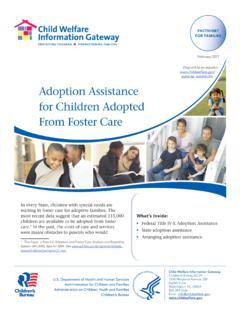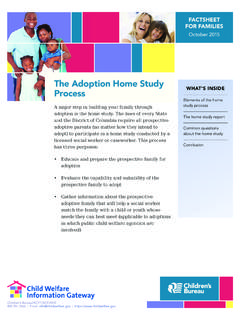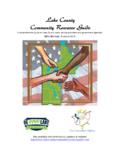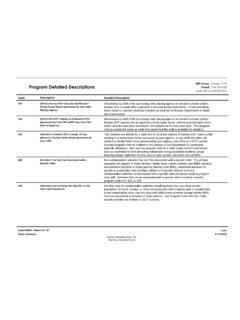Transcription of Child Welfare Consent Decrees - The Hill
1 Child Welfare Consent Decrees : Analysis of Thirty-Five Court Actions from 1995 to 2005 Legal Documents Reviewed and Analyzed by Law Student Summer 2005 Interns: Amy Kosanovich and Rachel Molly Joseph Assisted by Public Policy Intern: Kira Hasbargen With an Introduction by Shay Bilchik and Howard Davidson October 2005 Introduction A class action lawsuit is a civil court procedure under which one party, or a group of parties, sue as representatives of a larger class of For over a quarter-century, class action lawsuits have had a major impact on the operation of state and local Child protection systems. These lawsuits have often been used as tools to address failures by Child Welfare agencies to provide adequate services to children and parents and to achieve systemic reform that might otherwise have required legislation or many individual lawsuits. Over the past ten years alone, there has been Child Welfare class action litigation in 32 states, with Consent Decrees or settlement agreements in 30 of These lawsuits have often resulted in settlement agreements that become Consent Decrees upon approval by the court.
2 Once approved by the court, the Consent decree acts as a contract, binding the Child Welfare agency and the attorneys acting on behalf of the plaintiff class members to its terms, and it is fully enforceable by the The substance of the Consent decree describes specific actions defendants must take to resolve the identified problems, and the plaintiffs responsibilities to ensure the provisions in the decree are The Child Welfare League of America and the American Bar Association Center on Children and the Law have herein, for the first time to our knowledge, collected, analyzed, and categorized the systemic improvement topics addressed within Child Welfare 5 class action Consent Decrees , settlement agreements, and court orders/decisions that have impacted the Child Welfare system in the last two decades. We have spoken to contacts in all 50 states and the District of Columbia, and we believe, but cannot be absolutely certain, that we have identified an exhaustive and comprehensive list of class action suits (both federal and state) affecting the Child Welfare system.
3 In order to be included in this collection and analysis, a Consent decree , settlement, or court opinion/order had to either be currently affecting the operation of a state or local Child Welfare system, or it had to have expired within the past ten years. Using these criteria, we found 21 states where there was a currently operative court-approved Consent decree or court order, or where there was pending litigation brought against a public Child Welfare agency. In another 11 states, the court s formal involvement had ended, but the decree , agreement, or order was still deemed relevant for our analysis. 1 2 Suits have been brought against state as well as local Child Welfare agencies. 3 Theodore J. Stein, Child Welfare and the Law, Washington, DC: Child Welfare League of America, 1998 at 226. 4 Id. 5 Child Welfare is defined here to include an action that is brought to affect significant systemic change in the state and/or local agencies responsible for Child protective services, removal of children into out-of-home care, filing of juvenile court dependency petitions, permanency planning for children in foster care, termination of parental rights, adoption, and other issues affecting abused, neglected, and abandoned children.
4 2We have read all the settlement agreements, Consent Decrees and court orders we were able to obtain6, and we have charted the ways in which each addresses such areas as Protective Services, Placement, Services, Adoption, Planning, Caseworker Issues, Judicial and Legal Issues, and Resource In all, we have identified 58 Decrees , agreements, and orders from 32 states, including the District of Columbia. Because of the difficulty in obtaining all of the Decrees and agreements, this study analyzes 35 that were directly pertinent to our Of the Decrees , agreements, or orders analyzed, the substance of: 36 ( ) addressed placement issues such as recruitment, retention, licensing and training of foster parents, relative placements, and group homes; 31 ( ) addressed protective service issues such as reporting, investigating, and intake; 32 ( ) required the defendants to ensure the provision of certain services to children and their families, such as medical, dental and mental health examinations, parent- Child or sibling visitation, and independent living training; 30 ( ) required the defendants to address issues concerning caseworkers, such as adequate staffing, maximum caseloads, and enhanced training and supervision.
5 25 ( ) addressed planning issues such as permanency and identified case goals; 25 ( ) required some sort of new resource development, such as the creation of universal information systems or quality assurance reviews 16 (34%) addressed adoption issues; and 11 ( ) addressed reforms to the judicial system. We hope this analysis will be helpful to Child Welfare administrators, Child Welfare reform advocates, attorneys, guardians ad litem, court-appointed special advocates, judges, dependency court administrators, legislators, and others who want to better understand the results of these major legal actions. This will allow them to see, at a glance, major areas of the Child Welfare system that were affected by the Consent Decrees , and the objectives and outcomes required by these court orders or agreements. This project s materials will, we hope, help both policymakers and practitioners better understand the issues addressed in the final resolution of these cases and the collective outcomes of these suits.
6 As shown by the Decrees , settlements, and orders we have read, class action lawsuits can definitely effectuate large-scale systemic change for Child Welfare systems. Yet ideally, given the expense and time-consuming nature of litigation, systemic transformation and improvement would best occur in other ways, administratively and legislatively, without the need for such lawsuits. 6 We obtained 47 settlement agreements, Consent Decrees and court orders out of the 58 we identified. 7 See Part 1 below. 8 Examples of lawsuit issues that were not deemed pertinent to our study include: decree monitoring and enforcement mechanisms and issues of how to fund changes agreed upon in the Decrees . 3We want to be clear that we are neither endorsing nor critiquing the litigative process of achieving major change in Child Welfare agency policy and practice. We are simply hoping that this information can as states become involved in a second round of federal Child and Family Services Reviews and implementation of state Program Improvement Plans serve to better inform our field of systemic improvements that class actions lawsuits have addressed.
7 Shay Bilchik President and CEO Child Welfare League of America Howard Davidson Director ABA Center on Children and the Law 4 Summary Over the past ten years, thirty-two states have been involved in Child Welfare litigation, with thirty states entering into a Consent decree or settlement agreement as a result of the suit. These Decrees detail the various requirements and standards with which the state, under the jurisdiction of the court, must comply. The duration of these Decrees depend on how many service areas the state must address, and its success in implementing the requirements of the decree . Most Decrees that have been active within the past ten years have addressed the state s failure to: properly license and train foster parents; place children in adequate and safe foster and group homes; properly report, investigate and address abuse and neglect incidents; provide needed medical, dental, and mental health services to foster children; ensure adequate parent- Child or sibling visitation; ensure social workers have manageable caseloads, training and supervision; provide children and families with adequate case planning and review.
8 Expired Decrees Several states have successfully complied with the Consent Decrees governing their Child Welfare agency within the past ten years, and thus the Decrees were dismissed. Such states include Arkansas, Florida, Hawaii, Idaho, Kansas, Michigan, Minnesota, New Hampshire, New Mexico, New York and North Carolina. Many of these states have enacted legislation and/or policies as a result of the Decrees , and some continue to have advisory groups monitor the Child Welfare agencies activities. The following examples illustrate some of the results of the states successful compliance with the Decrees : In New Mexico, after close monitoring of the Joseph and Josephine A. v. Bolson Consent decree , the number of children successfully moved out of foster care to permanent homes dramatically As a result of the James O. decree in New Hampshire, foster children in need of special education services have IEPs that are being implemented, those students that weren t getting any education are now in school, and judges have made the decision-making process of a Child s placement much more inclusive, involving the school district as well as the Division of Children and Youth As a result of the Sheila A.
9 decree in Kansas, children now receive services within 4 hours of referral, out-of-home placements average 13 months (compared to the national average of 24 months), after-care is available to all 9 Children s Rights, 2005. 10 James O. v. Marston, Consent decree , Civil Action No: 86-6-S; Ronald Lospennato, Disability Rights Center. 5children for 12 months, crisis support is available to families 24 hours a day, 7 days a week, and 86% of children are placed either with a relative or a family foster Current Decrees Today, twenty-one states currently operate under court Consent Decrees , settlement agreements or are under pending litigation brought against public Child Welfare agencies: Alabama, Arizona, California, Connecticut, Georgia, Illinois, Indiana, Maryland, Mississippi, Missouri, New Hampshire, New Jersey, New York, Ohio, Pennsylvania, Rhode Island, Tennessee, Utah, Washington, West Virginia, and Wisconsin Twenty-six federal Consent Decrees or settlement agreements are currently governing Child Welfare agencies within these states.
10 Most of the current Decrees have been in effect for over six years, with approximately half of the Decrees in effect for over ten years. Some have governed the agencies for approximately twenty years, and others for less than four years. Several Decrees have been modified since the original agreement, with some modifications occurring within the past few years. Those cases with modified agreements still have areas with which the state is not complying, even though the state may be in successful compliance with other terms of the agreement. Although those Decrees are still outstanding, documented results in such states as Alabama, Wisconsin and New York have already been realized: The settlement in Alabama prompted statewide reform of the Child Welfare system, implementing a unique collaborative county-by-county model and dramatically improving the care of children in foster care and reducing their time in the In New York, as a result of the Marisol settlement, the Administration for Children s Services has achieved lower caseloads, obtained funding for additional placements, sharply increased staff training, vastly improved its data management system, and reconfigured foster care services along neighborhood As a result of the Jeanine B.








